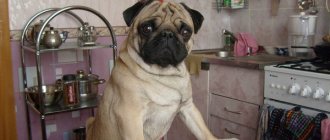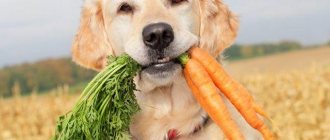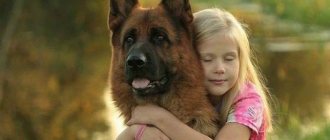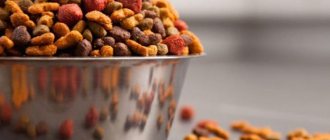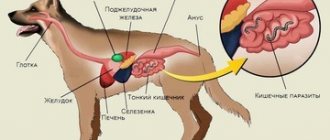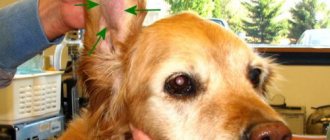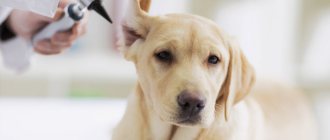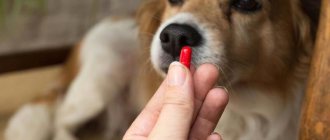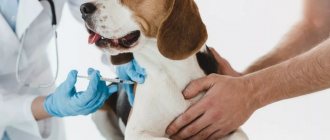What is rickets
This disease is associated with a deficiency in the dog’s body of elements such as calcium, vitamin D, and phosphorus. Most often, rickets develops in puppies and young animals up to one year of age.
Rickets is not a contagious disease; it cannot be transmitted to other pets or humans. Genetic predisposition also plays a small role here. In puppies, rickets can be cured quite easily, while in older individuals more severe pathologies can be observed - osteochondrosis, osteomalacia, and in bitches that have given birth - postpartum type eclampsia, which can even cause the death of the animal.
Consequences
Rickets in itself does not threaten the dog's life. But if not treated promptly, it can lead to disability. When calcium is washed out of the bones, the animal becomes susceptible to frequent fractures and bone bending. When the skeleton is deformed, it prevents the body from functioning normally. It is difficult for the dog to move, she is limping. Curvature of the pelvic bones causes difficult births. Internal organs function poorly. Rickets is especially dangerous for the cardiovascular system.
Causes
The main cause of rickets in a dog is a lack of vitamin D in its body. Most often this is due to an unbalanced diet, but sometimes this problem occurs when there is a malfunction in the body when it itself stops producing vitamin D.
The main causes of rickets:
- violation of metabolic processes;
- disruption of the parathyroid glands;
- liver dysfunction;
- imbalance of phosphorus and calcium metabolism in the body.
Dogs that are walked regularly rarely suffer from rickets. Under the influence of sunlight, the synthesis of vitamin D in the dog’s body increases, so indoor dogs are more often susceptible to this disease.
Causes of rickets in dogs
There are several causes of rickets in dogs:
- Lack of calcium in the diet.
- Lack of phosphorus.
- Lack of vitamin D.
At least one reason is enough for serious health problems to begin. Even if you enrich the diet with calcium and phosphorus, but do not give enough vitamin D, the dog will develop rickets. Without this vitamin (which can be produced in the animal’s body if it is exposed to ultraviolet radiation), calcium simply cannot be absorbed.
If there is not enough phosphorus, the balance is upset. In general, a seemingly harmless deficiency of one of the nutrients can lead to irreversible consequences. The bones will not straighten after rickets, they will remain like a wheel.
The onset of the disease may not be noticed, because there are no visible changes in the bones yet. The first, subtle signs include changes in the central nervous system. She feels that there are problems with metabolism in the body and gives alarming signals to the animal. At this stage of rickets, the dog becomes fearful and restless. She feels quickly tired, is unnaturally excitable, and has problems with reflection. In addition, the pet periodically experiences itching. The dog begins to itch and rub out its initially thick fur. The animal spends only a short time in this state – 2-3 weeks. After this, if no action is taken, a noticeable change in the bone apparatus appears. After all, there are no longer enough mineral salts to fully saturate the bones. In a rickets dog, the content of calcium salts in the bone skeleton is three times lower than expected by nature. This is reflected on the bones as follows:
- they are softer;
- feels sore;
- The shape of the bones changes easily.
The change in shape is most reflected in the limbs. After all, the main part of the body rests on the long bones of the paws. Due to the increased load, a thickening appears on each paw joint - a bracelet. The bones of the forearm become like an arch; in addition, they become very fragile and are easily susceptible to fractures. This problem especially affects large dogs. Naturally, because of all this, the pet has problems with movement.
Then comes the turn of the teeth. Healthy puppies already receive a fully formed jaw by the eighth month. A sick animal begins to lose its baby teeth at about one year of age. In addition, some teeth change shape, sometimes this disfigures the dog. The condition of the enamel of such teeth is critical; they become yellow and crumble. Due to the elongation of the upper jaw and deformation of the lower jaw, the natural bite is disrupted.
Symptoms
The signs of rickets are very varied, but identifying this disease is quite easy.
The main symptoms of rickets in a dog:
- Curvature of the spine, severe stoop
- O weakening of muscles. When walking, the dog has bent paws. They are soft and flabby to the touch, there is no tone in the muscles.
- Lethargy, fatigue of the dog. She doesn't want to play and doesn't ask to go outside.
- Osteochondrosis. If rickets has led to the appearance of osteochondrosis, thickening of the joints on the paws will be observed. Nodular formations appear in the area of the ribs.
- Impaired dental development. They can grow crookedly, fall out and crumble.
- Inappropriate behavior. A dog can eat anything - dirt, soil, its own feces, lick the floor, walls, doors.
- Bone fragility. A dog with rickets is often susceptible to bone fractures. Even a slight blow or fall can cause serious injury.
- Changes in the chest. It becomes too wide because the skeletal system cannot cope with the weight, causing the dog's chest to bulge.
- Apathy. Sluggish response to stimuli.
- Problems with wool. Vitamin deficiency causes dulling of the coat, dandruff and bald patches.
If left untreated, complications of rickets will occur: liver, heart, and kidney diseases. If the disease is advanced, it often leads to deformation of the ribs and pelvic bones, and in severe cases, to the death of the pet.
Symptoms of rickets
What rickets looks like depends on the stage of development of the disease; a clear clinical picture appears only at a late stage of the pathology:
First, the animal exhibits a perverted appetite; the puppy tries to eat inedible objects, even feces and soil. Because of this, indigestion develops, greenish diarrhea, dysbacteriosis with flatulence. At this stage, rickets can be suspected due to slower tooth change and deterioration of enamel.
Then rapid fatigue, lethargy, uncertainty and unsteadiness of gait are detected. Sometimes lameness, trembling of the limbs are clearly visible, and an increase in temperature is felt. Bones become brittle, break easily, and the incidence of fractures increases significantly.
At a later stage, rickets can be identified by thickening of the joints and curvature of the bones, which greatly affects the gait. There is also flabbiness of the muscles, weakness of the muscle corset, which is why the back begins to sag. When moving, the animal feels quite severe pain.
The back sags and becomes half hunchbacked. When palpating the ribs, hard nodes can be detected on them. The shepherd's joints are bent due to their heavy body, so it becomes very painful to walk, as a result they completely refuse to move. Limbs turn inward or outward.
Prevention
Many dog breeders are interested in whether it is possible to prevent rickets in a dog? This is quite possible if you adhere to certain rules for feeding and walking the dog.
Nutrition
The dog's diet must contain all the substances it needs. This is especially important for a puppy who is actively developing bones and organs. It is not advisable to give your puppy only one type of food. A varied diet is the key to a healthy pet.
The animal's diet should contain meat dishes, cereals, and dairy products. It should be taken into account that natural milk is poorly absorbed by the pet’s body. It is better to give him fermented milk products - fermented baked milk, kefir, yogurt, sour cream, cottage cheese.
Vitamins
It is recommended to add special vitamin supplements and fish oil to your puppy's food.
Walking in the sun
The best preventative measure against canine rickets is daily walks in the sun. You can also walk in cloudy weather - ultraviolet rays can penetrate even through clouds, but in smaller volumes.
Treatment of rickets in dogs
How to cure rickets in a dog? If the veterinarian confirms the diagnosis is valid, treatment should be started as soon as possible to avoid serious complications. The process is not fast, not cheap, and not always effective. Be sure to visit your veterinarian before starting treatment. He should determine what exactly your pet is missing. And only after this can treatment begin.
- If there is not enough vitamin, then the ideal would be to use the drug ergocalciferol (dosage 5-10 thousand IU). Do not exceed it, otherwise there will be hypervitaminosis.
- Together with ergocalciferol, it is necessary to administer calcium gluconate intravenously (only 0.5 ml). Frequency - a couple of times a week (twice - three times).
- You will need another trivitamin. It is administered either intramuscularly twice (sometimes once) at a dosage of 1 ml for every 10 kilograms of the pet’s live weight, or it is dripped directly into the mouth (from one to ten drops). This will strengthen the immune system and support your baby.
You should not stop at therapy with vitamin D alone. It would be a good idea to add capsules of retinol (vitamin A), tocopherol (E), duovit, aevit and other vitamin complexes to the treatment of a dog for rickets. But there is no need to exceed the dose. Carry out everything as prescribed by your veterinarian.
And be sure to walk longer. Not 5 minutes purely to relieve needs, but a full-fledged long walk in the sun, so that the puppy is “exposed” to ultraviolet light, thereby stimulating the production of vitamin D3 in its body.
Prevention of rickets in dogs
The only thing cheaper than treatment is preventing rickets in a puppy. And it's the simplest. First of all, you need to create a diet that contains everything in the required quantities. This is why it is so important to feed your puppy properly. There is no need to give only one type of food. Be sure to diversify your dog's menu. It should contain not only meat and cereals, but also dairy products. Plain milk is not always digestible. Yes, at a very young age, enzymes are present in the puppy’s intestines that break down the components of milk. But as they grow older, there is nothing left of these enzymes, so after the dog drinks milk, it begins to have diarrhea.
It is for this reason that it is recommended to add “sour” milk to the diet: kefir, sour cream, fermented baked milk, cottage cheese, yogurt (unsweetened and without various additives, such natural yogurt can be prepared yourself from milk and a special starter culture). These foods should be in your bowl every day. Just add enough so that the puppy eats everything. And after a meal, be sure to wash the bowl thoroughly so that the product does not spoil and your pet does not get poisoned.
You can add special vitamins for puppies to your food. Apply exactly as much as needed according to the instructions. Don't forget about minerals. You can often find specialized fortified fish oil on sale. You will have to forcefully pour it into the puppy’s mouth; it is unlikely that the baby will agree to accept it voluntarily. No need to give daily. The ideal frequency is every other day. The quantity depends on the size of the puppy. The smaller it is, the smaller the dose. And it varies from 3 to 30 ml at a time.
Just make sure that the puppy does not grab anything from the ground or sniff with other pets before vaccination, otherwise there is a high risk that the small pet will contract distemper, parvovirus enteritis or other infectious diseases.
Still have questions? You can ask them to our site's in-house veterinarian in the comment box below, who will respond to them as soon as possible.
Treatment
To diagnose rickets, the veterinarian conducts an external examination of the dog, and also prescribes a series of examinations to confirm the diagnosis: a biochemical blood test, radiography and other procedures that allow one to assess the content of phosphorus and calcium in the body, as well as the level of damage to internal organs.
Treatment of rickets should begin as early as possible, since this disease can cause many serious complications. Therapy consists of using drugs that restore the balance of microelements in the dog’s body. Usually prescribed drugs are: Catozal, Calcidi, Borgluconate, Trivit, Gamavit, Caforsen, Tetravit. Some drugs are added to food, while others are injected. It is also recommended to add gelatin dissolved in water to your dog's food.
In addition, it is recommended to walk your dog more often. In adults, it is almost impossible to cure rickets. The skeletal system has already been formed and it will not be possible to straighten it with diet pills. Treatment in this case will be aimed at strengthening the dog’s muscles, which will provide support for the deformed bones.
Since the treatment of rickets is a very long and complex process, a lot of effort will be required to prevent this disease. The puppy should receive the full range of substances it needs, move more and walk in the open air more often. To choose the right food, it is recommended to consult an experienced dog handler.
Diagnosis of the disease
In order to diagnose rickets in puppies, the symptoms of which at an advanced stage are visible to the naked eye, it is necessary to conduct a series of examinations. The veterinarian prescribes:
- Blood test for biochemistry and calcium and phosphorus content.
- X-ray.
- Assessment of motor functions.
- A general examination of the pet is carried out.
Once the diagnosis is confirmed, appropriate treatment is prescribed.
Reasons for the development of rickets
The main cause of this disease is the lack of vitamin D and calcium in animal feed. But in fact, this is just the tip of the iceberg.
The reasons are much more varied:
- Diseases of the gastrointestinal tract (regardless of origin). In this case, the necessary substances are simply not absorbed.
- Liver pathologies. In this case, the organ cannot synthesize one of the hormones necessary for the normal absorption of calcium by the body.
- Congenital or acquired diseases of the endocrine glands. The resulting hormonal imbalances lead to poor absorption of calcium, or to its rapid leaching from the body.
Kidney disease as a cause of rickets
They need to be considered separately, since kidney pathologies are often found in older dogs. Above, we considered only “classical” situations when the disease develops due to poor nutrition. But in practice, there are many cases when pathology is detected in animals whose diet is completely fine... Experienced veterinarians begin to “dig” towards increased excretion (that is, release) of calcium from the cat’s body.
It must be remembered that normally excess Ca is excreted in excrement. Again, normally very little calcium is excreted through the kidneys. But with chronic hypercalcemia, for example, an element necessary for the body begins to be abundantly released into the external environment with urine. But the reason may be (and most often it is) related to the condition of the kidneys themselves.
If they are healthy, then during the formation of primary urine, all calcium in the blood plasma is “secondarily absorbed” by the renal tubules and returns to the general bloodstream. In the case when something is wrong with the organ (nephritis, for example), the formation of secondary urine is difficult or completely impossible, and therefore all Ca (as well as other micro- and macroelements, protein) is simply washed out into the external environment.
Consequences of rickets
Rickets and osteoporosis are quite serious diseases in themselves, but their consequences are much more serious. In particular, in older animals who suffered from rickets in early childhood, problems with bone tissue and other organ systems do not disappear. They lack teeth, their legs are deformed, bending into an arch, and due to the deformation of the chest, the animal breathes heavily and hoarsely. Such dogs are physically incapable of long walks, as they begin to choke during walks.
In adult animals, a lack of the vitamin leads to osteomalacia, which causes bones to become soft and weak. Symptoms of the disease include: muscle weakness and spasms, bone pain, numbness and bone deformity. In addition, a lack of vitamin D3 contributes to the development of osteoporosis, because its deficiency interferes with the absorption of calcium.
As a result, demineralization of bone tissue occurs, leading to a decrease in bone density, a change in its structure, which ultimately causes increased fragility. A sick dog can break half of its bones just by trying to jump. Of course, animals rarely survive to such advanced cases, since they die much earlier from severe disorders of water-salt metabolism.
Thus, curing rickets in adult animals and puppies is not an easy task. It is much better to prevent the development of these pathologies by controlling the nutritional characteristics of your pets.
Why does it appear
Bone, as the main part of the skeleton, has a complex chemical structure, which includes both organic and inorganic components. The latter include primarily calcium, magnesium and phosphorus. In order for bone tissue to form correctly, it is not enough for the mentioned minerals to enter the body. It is equally important that they are in the correct proportion with each other and, in addition, the necessary conditions for their assimilation are created. The main regulator of calcium-phosphorus metabolism in the body is vitamin D, which ensures the absorption of calcium, magnesium and phosphorus into the blood and their subsequent deposition in the bones.
Important! The optimal ratio of calcium to phosphorus in a puppy's body should be approximately 1.2:1. An excess of calcium is no less dangerous for a growing animal than a deficiency, because in the process of evolution, dogs, mainly living in conditions of calcium deficiency, did not acquire the ability to deal with the reverse imbalance.
Depending on the deficiency of which particular component of calcium-phosphorus metabolism is responsible for the development of the pathology, three main types of rickets are distinguished:
- calciumpenic (calcium deficiency);
- phosphopenic (phosphorus deficiency);
- vitamin D-dependent (vitamin D deficiency with normal calcium and phosphorus levels).
Lack or excess of vitamins
Scientists have calculated how much calcium, phosphorus and vitamin D a dog should normally receive. These indicators are calculated per 1 kg of animal body weight and are:
| Component | Daily value for a puppy, mg per 1 kg of weight | Daily value for an adult, mg per 1 kg of weight |
| Calcium | 320–529 | 120–265 |
| Phosphorus | 266–440 | 100–220 |
| Vitamin D | 10 | 20 |
Despite the fact that the direct cause of rickets is a lack or excess of one of the three mentioned components, this complex pathology can also develop against the background of more complex metabolic disorders in the body, which, in turn, sometimes arise as a result of improper or unbalanced nutrition, in in particular, excess fat, lack of proteins, iron, copper and other trace elements, deficiency of B vitamins, especially thiamine, riboflavin and pyridoxine.
Important! Failure to maintain the balance of nutrients in the diet of a pregnant dog is a much more likely cause of the development of rickets in puppies than improper feeding of the babies themselves during the first year of life.
Factors that lead to a lack of important nutrients in the embryonic stage also include:
- too many puppies in the litter;
- various pathologies of pregnancy;
- allowing a bitch that has not reached full sexual maturity to mate;
- a short period between pregnancies, when the mother’s body does not have time to fully recover;
- premature birth;
- rare exposure of the mother to the sun (lack of vitamin D production in the skin);
- the dog's sedentary lifestyle during pregnancy accompanied by increased feeding, which leads to the birth of overweight puppies;
- poor ecology in the region (high smoke levels in the atmospheric air also impede the synthesis of cholecalciferol).
Another common reason for the development of rickets in puppies is improper artificial feeding. If for some reason a whelping dog does not have enough milk of its own, the cubs have to be supplemented by the owner. For this purpose, you should never use cow's or goat's milk, since such products contain at least 6 times the permissible level of calcium and phosphorus.
By the way, baby food is also not suitable for these purposes, but for a different reason - it contains too much sugar (6.5–7% versus the required 3.1%). Therefore, the best option is to purchase a ready-made mixture from the “artificial bitch’s milk” line in specialized stores. Many manufacturers of premium and super-premium animal feed (Royal Canin, Canina, Beaphar, Nutri-Vet, Hartz, etc.) produce this kind of supplement.
Did you know? As soon as ready-made milk formulas for artificial feeding appeared in a wide assortment on store shelves, the global problem of rickets in infants was solved. It turns out that the main cause of this disease was the use of cow's milk as a substitute for mother's milk.
Infectious diseases
Some diseases, including infectious ones, which either the baby himself or his mother suffered from during pregnancy, can also contribute to the development of rickets in puppies. This group primarily includes:
- acute respiratory viral infections;
- bacterial, viral or fungal infections of the intestines;
- skin diseases that impede the production of cholecalciferol (vitamin D);
- malabsorption, or syndrome of impaired digestion and absorption, is a pathological condition in which certain nutrients cannot be absorbed by the small intestine, as a result, metabolic processes are disrupted, including calcium-phosphorus metabolism;
- diseases of the gastrointestinal tract due to increased acidity of gastric juice;
- many gynecological pathologies or complications of pregnancy (so-called extragenital diseases);
- pathologies of the liver and kidneys of any nature.
The last item on the list requires a separate explanation. The fact is that vitamin D itself is useless in the body. This substance acquires the ability to influence certain metabolic processes only after it has gone through a whole cycle of biochemical transformations, and these transformations occur precisely in the liver and kidneys. The substances that appear as a result are usually called active metabolites of vitamin D. These are calciferol (25-hydroxyvitamin D, or 25(OH)D) and calcitriol (1,25-dihydroxyvitamin D, or 1,25(OH)2D).
Disturbances in calcium-phosphorus metabolism may also be caused not so much by the disease itself as by taking certain medications used to treat it. The greatest danger in this regard are:
- anticonvulsants;
- glucocorticoids;
- antibiotics (especially tetracycline group);
- heparin;
- some hormonal agents (for example, thyroid hormones);
- antacids (drugs that neutralize hydrochloric acid in gastric juice).
Did you know? The English physician Edward Mellanby (1884–1955) is considered the discoverer of vitamin D. During experiments on dogs, the scientist discovered that cod oil is a natural cure for rickets, although at first Mellanby mistakenly attributed the anti-rachitic properties to vitamin A, already known at that time.
Which dogs are at risk?
Since rickets in general cannot be characterized as a hereditary pathology, the risk group includes any dog, regardless of breed size. However, some researchers note that rickets is most severely diagnosed in puppies of large and heavy breeds, in particular:
- Great Danes;
- Mastino Neapolitan;
- German, Caucasian, Central Asian and East European shepherd dogs;
- St. Bernards;
- Irish wolfhounds, etc.
The second category of animals included in the risk group are breeds in which, during the selection process, non-standard skeletal shapes were deliberately formed, in particular, shortened or crooked limbs. The first thing to remember here is:
- bulldogs;
- bull terriers;
- dachshund;
- basset hounds;
- Rottweilers;
- Shar Pei.
Finally, the third type of breeds susceptible to rickets are dogs with thin legs and an overly graceful constitution, for example:
- chihuahua;
- Toy Terrier;
- Italian Greyhound;
- African, Hort and other types of greyhounds.
And yet you need to understand that rickets is a universal pathology. The breeds listed above are at risk not because they suffer from rickets more often than others, but because it is not fatal, in general, the disease affects the general health of such an animal much more strongly, causes it more suffering and inconvenience, and affects the appearance much more bright.
Prevention of rickets
Preventive measures should be started when the dog is expecting offspring. Vitamins and dietary supplements that contain calcium should be given daily. For a pregnant bitch, the food must be special; special premium food is recommended. Long walks are required, especially on sunny days.
Puppies should not be taken away from their mother early. By feeding on her milk, the cub will receive complete nutrition, which includes everything that is necessary for its body.
When introducing complementary foods, crushed eggshells, cottage cheese, and vitamins should be added to the food. If you plan to feed the puppies with ready-made food, then you should purchase only expensive food, the composition of which is balanced and contains all the necessary vitamins and microelements.


